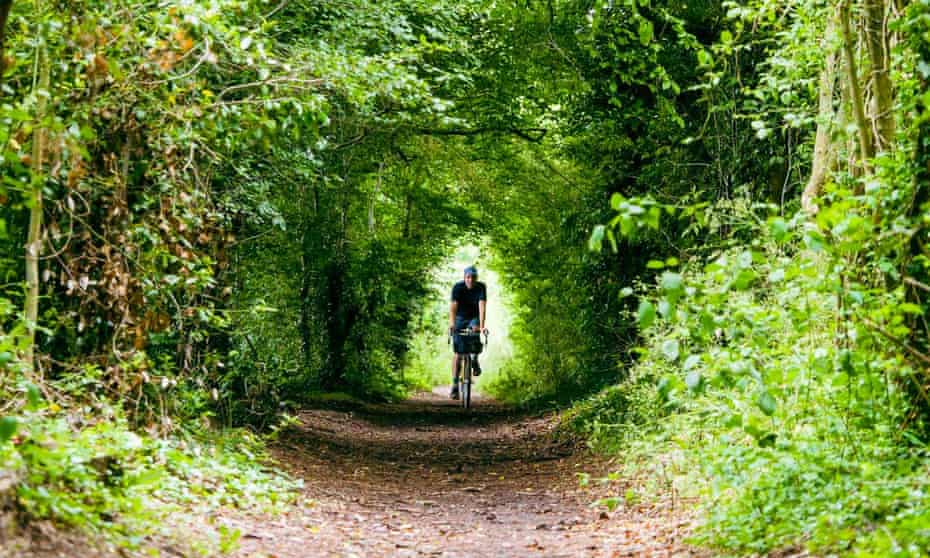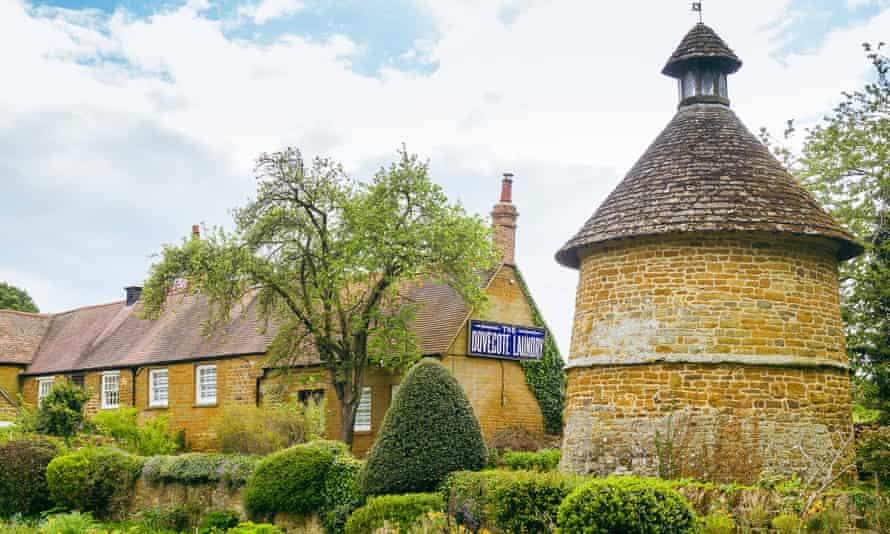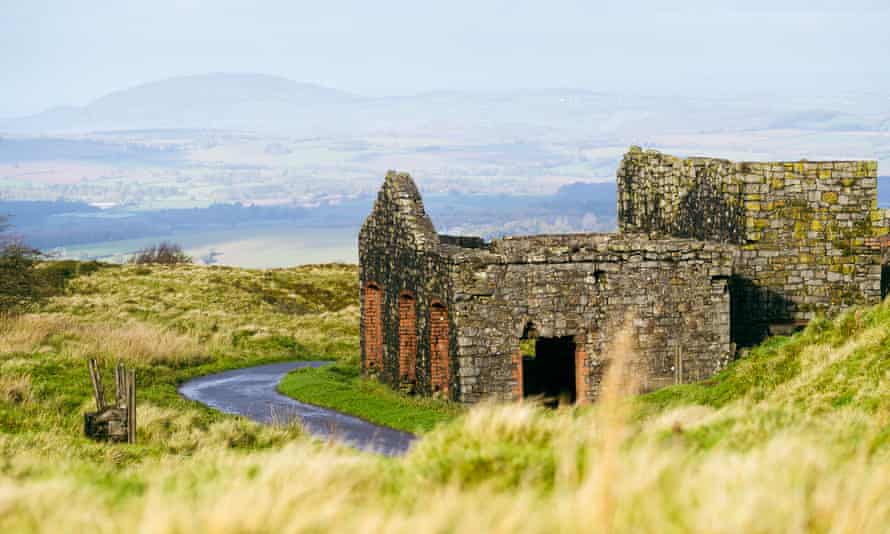
Taking in backcountry from Leicestershire to Shropshire, these 30 to 50-mile routes, included in a new book, feature beautiful villages, countryside and places to stay
Stilton and pork pies, high Leicestershire
Start/finish Melton Mowbray
Distance 34 miles
This ride will refute any misguided belief that Leicestershire is flat. “High” Leicestershire lies between Melton Mowbray and Market Harborough: a rural enclave of broad, rolling ridges and secluded valleys. What makes the area especially good for cycling is its dense network of quiet country lanes, the least travelled of which have farm gates that you open and close as you go.
My route begins in Melton Mowbray, heading due south from the town centre on to a gem of a gated road that leads to Burrough Hill, one of the highest points in the county. After a pleasantly meandering section on more choice gated roads via Newbold and Owston is Launde Abbey, a former monastic house tucked away in the gently sheltered combe of the River Chater. It is a spot so beautiful that Thomas Cromwell, chief adviser to Henry VIII and in charge of the redistribution of England’s vast monastic wealth, earmarked Launde for himself as a place to where he might retire and grow old. The executioner’s axe meant it was never to be, and the abbey is now a Christian education centre.

More lanes and a great traffic-free byway leads into the county of Rutland and the pretty villages of Belton, Brooke and Braunston. Built from the rich orange ironstone that is a distinctive architectural feature of the area, all three have 12th-century churches worth a stop, especially Brooke with its Elizabethan oak interior.
The return route, via Knossington and Somerby (whose village pub is the excellent Stilton Cheese Inn), passes the entrance to the iron age hill fort on Burrough Hill. The last miles back to Melton take in a farm byway that is just about passable before picking up the same glorious gated road of the start of the ride.
Lunch The Blue Ball, Braunston. This 17th-century thatched inn claims to be the oldest in Rutland. Cosy in winter with outside seating in summer.
History Burrough Hill iron age hill fort, a site of major archeological significance and one of the best sunset viewpoints in the east Midlands.
Stay The Admiral Hornblower, in Oakham (doubles from £90 B&B), offers good value rooms in a characterful 17th-century former farmhouse, two miles off the route from Brooke.
Squires and spires, Northamptonshire

Start/finish Northampton
Distance 48 miles
Whether you see them as glittering repositories of history and culture, or emblems of injustice and oppression at home and abroad, the UK’s landed estates have shaped the countryside. Northamptonshire has one of the highest concentrations of stately homes of any county in England and this ride takes in five, connected by some choice lanes and traffic-free trails.
From the centre of Northampton, head north on Brampton Valley Way, the route of a disused railway line, as far as Brixworth (the village’s magnificent Saxon church is a short detour up the hill). A few miles on is Cottesbrooke Hall, with its beautiful 5.2 hectare (13-acre) originally Arts and Crafts garden designed by Robert Weir Schultz in the first decade of the 20th century. A steady climb leads to the broad ridge near Naseby, where on the foggy morning of 14 June in 1645, the New Model Army of Oliver Cromwell inflicted a decisive defeat on the main Royalist army of King Charles I.
After passing through the grounds of Stanford Hall and crossing the M1 by bridge, a quiet lane leads to the handsome village of Ashby St Ledgers. From just south of the village of Norton, a sublime wooded bridleway just south of the Watford Gap crosses back over the motorway, a canal and a railway line into the landscaped parkland of Brockhall Hall. A good gravel track connects to Little Brington and into the orbit of Althorp, the last and grandest of the route’s landed estates.

The Spencer family rose from sheep farming minor gentry to become one of the most prominent and wealthy families in Elizabethan England. Elaborate memorials to generations of Spencers fill the church at Great Brington, from where an avenue of trees leads to Althorp House. The most famous Spencer of all, Diana, Princess of Wales, is buried in a mausoleum on an island in the grounds, which is strictly off-limits. The last miles back through the suburban outskirts of Northampton are efficient, if lacking the genteel splendour of the rest of the ride.
Lunch Pickle and Pie, 23 Church St, Crick. Outstanding hot lunches, coffee and more.
History The half-timbered gatehouse of the manor at Ashby St Ledgers is where Robert Catesby hatched the gunpowder plot to blow up parliament and kill the king. We remember Guy Fawkes, but Catesby was the mastermind.
Stay The Hollies B&B (doubles from £70), South Kilworth. Stylish, good value B&B just north of the route’s halfway point.
Bournville and the Bard, Birmingham to Warwick

Start Birmingham
Finish Warwick
Distance 46 miles
The West Midlands green belt is the size of the Peak District and the Shropshire Hills combined and keeps suburban sprawl in check while providing precious rural space. This linear route shows just how easy and satisfying it is to ride from a big city into the countryside and then hop on a train back.
The route out of Birmingham follows the Rea Valley Cyclepath (part of National Cycle Route 5) passing close to Birmingham Central Mosque and Edgbaston Cricket Ground, and then into Cannon Hill Park, a 32-hectare (80-acre) landscaped pleasure garden. It skirts Bournville, the famous “factory in a garden” built in the 1890s by the Cadbury family of chocolate-making Quakers, who sought to “alleviate the evils of modern, more cramped living conditions”. After a section of canal towpath the route follows the ancient highway of Icknield Street into the Forest of Arden, one of the most fabled lost landscapes of Merrie England.

Picking a way south, my route keeps to the quietest of lanes to Wilmcote, where Shakespeare’s mother, Mary Arden, was born. Her house and the adjoining farm are run as a working Tudor farm (currently only open to local schools). From here the canal towpath offers an easy ride into Stratford-upon-Avon, a handsome Warwickshire town that makes much of being the birthplace of the Bard but suffers under the burden of its visitors. There is a train bailout from Stratford but my route negotiates the town’s cycling-unfriendly one-way system to follow National Cycle Route 41 to Warwick via Wellesbourne airfield, a former RAF base with a small museum and cafe and Charlecote, a very grand Elizabethan country house and landscaped grounds. The ride ends at the ancient Mercian stronghold of Warwick, with its elegant town centre and sensational castle.
Lunch Coach and Horses Inn, nr Alvechurch, Worcs. Real ale pub that is a favourite with local cyclists. Bar food served all day.
History Charlecote Mill is a working water mill that offers guided tours. There’s a good swimming spot around the back in the Avon.
Stay Twitey’s Tipis and Camping Meadows at Lowe Farm, Hunscote (standard pitch £14pp, glamping from £210 for two nights), is an excellent car-free campsite option just off-route.
Rollercoaster ride, Churnet valley, Staffordshire

Start/finish Denstone
Distance 31 miles
The Churnet Valley is a Staffordshire hidden gem. A bike ride might not deliver the same dose of pure adrenaline as a rollercoaster at nearby Alton Towers but it does promise constantly changing scenery and some fascinating industrial history. It is also a workout for the legs: the Churnet Valley is too narrow to accommodate a road along the valley floor, so there’s a fair bit of climbing and descending.
Starting in Denstone, my route sets out north-east towards Ellastone and turns west on a densely wooded lane squeezed between Alton Towers, once a country seat of the Earls of Shrewsbury, and Wootton Lodge, a Jacobean house built in 1611. After a rich history including being besieged during the English civil war, Wootton Lodge was bought by Joseph Cyril Bamford in the early 1960s, who founded digger manufacturer JCB. The company’s global headquarters is on a huge campus just down the road at Rocester.
After a stiff climb up Carr Bank the route passes neatly walled hay meadows on a lane beneath the ridge line of Ipstones Edge. It’s another descent back to the river at Cheddleton. There has been a mill here since the 1200s but in the late 1700s it was converted to grind flint for the pottery industry in Stoke-on-Trent, including for Josiah Wedgwood’s famous Jasperware. Canals are always tranquil places, and the steam trains that run on the heritage railway line conjure the atmosphere of a quieter age before the arrival of cars.
The return journey initially follows the unsurfaced canal towpath to Froghall and then uphill one last time, initially on the A521 to Kingsley Holt, but soon on to quieter lanes. The wooded descent down the Dimmingsdale Valley on a carriage drive built for the earls of Shrewsbury is a highlight of the ride. Back once again at the river, it’s a fairly swift return to Denstone along the old railway line, now a walking and cycling route.
Lunch Black Lion Inn, Consall Forge. Traditional canal-side pub with a lovely car-free setting. Real ales, pub fare.
History The Churnet Valley has a long industrial history of iron and metal-making. The copper cable used in the first ever transatlantic telegraph was made at the wireworks at Oakamoor.
Stay Manor House Farm, Prestwood (doubles from £45pp B&B), offers comfortable rooms in a Jacobean farmhouse. Next door is the Farm on the Hill (from £10pp a night) eco-campsite with private pitches and bike hire, set among woodland and wildflower meadows.
Castles and coral, Shropshire Hills

Start/finish Ludlow
Distance 49 miles
Ludlow makes the perfect base in a county that’s endlessly rewarding to explore by bike. Head west into a labyrinth of lanes that lead to the Welsh border, or north, as in this route, into the broad valleys of Apedale and Corve Dale, the wooded slopes of Wenlock Edge and the Clee Hills. Expect narrow and twisting country lanes, splendid trees, big views and just the right balance of climbing and easy pedalling.
The route north out of Ludlow follows National Cycle Route 44 from beneath the walls of Ludlow Castle and along the River Teme and then one its tributaries, the River Onny. It then cuts across Hope Dale and Apedale, with views to shapely Caer Caradoc. With a wealth of buildings from the 16th century and a few even older, the village of Cardington oozes rustic charm. The dark, wooded scarp slope of Wenlock Edge looms in the east. This limestone ridge – the remnants of a 400-million-year-old coral reef – is the defining landscape feature of the area and the route ascends to a col between its two highest points.

After a descent into Corve Dale, it’s uphill once again, on the climb up Brown Clee Hill: at 540 metres, the highest point in Shropshire. A balcony lane that follows the contour of the hill at about 350 metres and the climb to the top is an optional extra. Abdon Burf is a challenge for even the strongest of legs. Of course, there is no shame in walking up, and panoramic view from the top is ample reward for the effort.
The circuit around Brown Clee Hill ends with a traffic-free run on the estate road through Burwarton Park. The B4364 is the direct route back to Ludlow, but I opt for a roundabout route on farm lanes via Bitterley, and a farm byway. Squirrel Lane leads back to Ludlow.
Lunch The Royal Oak, Cardington, is a 15th-century pub with low-beamed rooms, quarry tiled floors and inglenook fireplace. Try the cider-infused fidget pie.
History Brown Clee Hill was the scene of eight air crashes during the second world war, more than any other hill in the UK. The lake on the summit still contains the remains of a Wellington bomber.
Stay The Mount Guest House, Ludlow (doubles from £115 B&B), has views over the town and is cycling-friendly. The Pheasant, Neenton (doubles from £90 B&B), is a superb community-owned pub with rooms that makes a good overnight stop on the route.
Jack Thurston’s Lost Lanes Central England (£16.99) is published by Wild Things Publishing. It is available from Guardian Bookshop for £14.78. Online GPX maps turn-by-turn route directions for these five routes are accessible at lostlanes.co.uk


